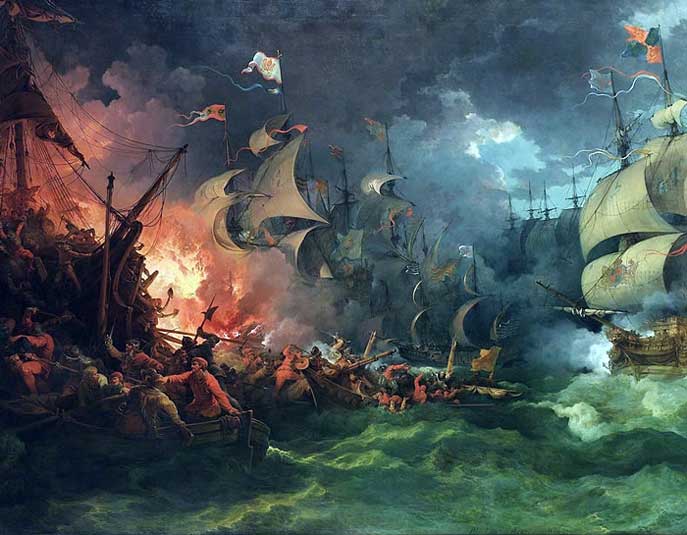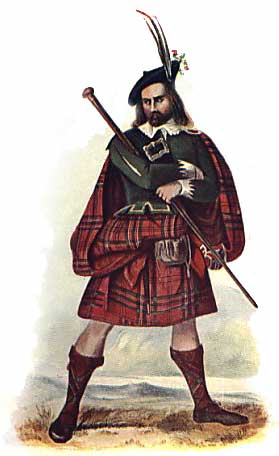THE SPANISH ARMADA IN SCOTLAND |
 |
After the defeat of the Spanish armada by the English navy in 1588, it is said that a critically damaged Spanish vessel took shelter in the bay of Tobermory on the Isle of Mull, Scotland. The ships that survived the English onslaught were forced to navigate
their way home around the north and west coasts of Scotland. Several
ships were lost along the treacherous Scottish coastline in terrible weather. |
 |
FACT OR FICTION? |
 |
I'm not one to spoil a good story by letting the facts get in the way . But there are some stories that contain so much information, most of it conflicting, that the process of separating fact from fiction becomes an almost impossible task. All of which brings us to the town of Tobermory on the Isle of Mull - more specifically, to its bay Even children's books carry the story which has now been passed down through generations - that of the sunken galleon from the Spanish Armada which lies buried in the silt at the bottom of Tobermory Bay, complete with its haul of gold doubloons. The vessel was - so the story goes - blown up by locals, drowning hundreds of sailors, because she was trying to leave port without paying her dues. It is a great story. Local people can recount the details as if they were there. The tourist industry on Mull positively thrives on it. But is there really a galleon? If so, which one was it and why was she in, of all places, Tobermory? More importantly, how much money and treasure lies beneath the sea only 400 yards from the pier in the port's small harbour? The prevailing theory among those who have taken time to study the subject is that an Armada vessel most certainly found refuge in the sheltered waters of the bay. When the Armada was defeated in 1588 many vessels headed round the north coast of Scotland to escape the English. A number came to grief, notable El Gran Grifón off the coast of Fair Isle. The name of the vessel which met its end in Tobermory Bay alters depending on who you listen to. Many claim it was the Almirante di Florencia, one of the treasure ships of the Armada. Often known simply as the Florencia, or the Florida, she would have been laden with the most fabulous Spanish gold and treasure. Others say the vessel was the San Juan de Sicilia (or San Juan de Baptista), with plenty troops on board but little in the way of treasure. |
Finding the lee of Tobermory in the middle of winter was no mean feat for the Spaniards and it is highly unlikely they just happened upon it. More probably they were led there, either by a friendly vessel or after having captured a local fishing boat. Once in Tobermory they were in waters owned by Mull's leading clan chief, Sir Lachlan Maclean of Duart Castle. A ruthless character, he would have known about any treasure chests on board the Spanish ship and would have been anxious to use anything that would help him increase his hold over the then important sea route between Argyll and the north coast of Ireland. Whatever his motives, the story goes that either Maclean himself, some of his family or an emissary acting on his behalf (possibly an undercover agent from the English government) boarded the galleon and ignited its powder store causing a huge explosion which sunk not only the boat and the sailors on board - but also the treasure. Over the years some - but very few - valuable artefacts have been recovered. The story among locals is that the galleon has simply sunk into the silt at the seabed. So of all the theories, which are most likely? Local historian Dr Jean Whittaker recently completed a book Lost Treasure which deals with all the galleon myths. Whittaker is convinced there was a ship there in the first place and further that it was the San Juan de Sicilia (or Baptista) which she claimed was simply commandeered by the Armada while in port in Sicily. "I used to think that the most likely thing that happened to it was an accident and I still think that," Whittaker says. "However the English government were fairly panicky at the thought of these vessels dotted round the Scottish coast. They did not realise they were in such bad shape but Queen Elizabeth I, on hearing one was cosily tucked away in Tobermory, may have reacted quite strongly. "After having routed the Armada they did not want any possibility of Mull being used as a Spanish offensive and it's not too much of an exaggeration to think that the English government was responsible for the explosion. I'm not saying that's definitive but it certainly shouldn't be discounted," she says. And so that, as they say, is the story in Tobermory. Believe it if you will. |
 |
© Paisley Tartan Army 2008-09
